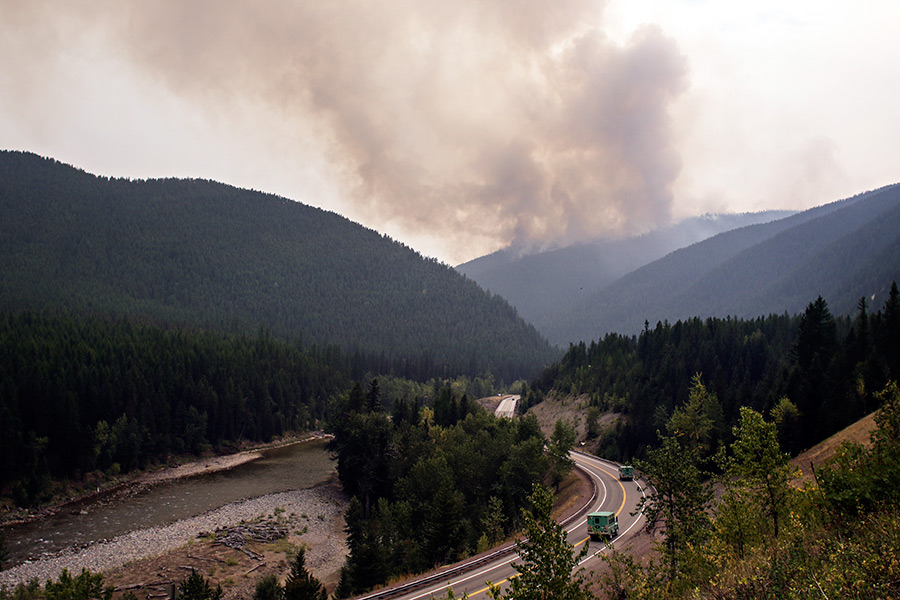Cool Weather Gives Firefighters a ‘Window of Opportunity,’ But Season Far From Over
People return home in Essex and Libby, but Heart Butte remains evacuated after fire rages out of Badger-Two Medicine region and on to Blackfeet Reservation
By Justin Franz
Aug. 31, 2:30 p.m.
Cool weather has helped firefighters gain ground on the more than one-dozen major fires burning in Northwest Montana, but officials say this year’s historic wildfire season is still far from over.
As of Aug. 31, at least 193,000 acres, or 301 square miles, burned in major fires across the region from the Idaho border east to the Blackfeet Indian Reservation. More than 270,000 acres, or 421 square miles, have burned in all of Montana, making it the largest fire season since 2012, which was the state’s largest season in a century.
A cold front swept across Northwest Montana during the final days of August, bringing considerably cooler temperatures and even some rain. But Flathead County Fire Service Area Manger Lincoln Chute said it’s not enough to calm the flames for good.
“We had a little rain but it didn’t put anything out and all we need is another warm day and we’re basically right back where we were,” Chute said. “But we have a window of opportunity to get some work done on these fires.”
On Aug. 31, the Flathead County sheriff’s office lifted the mandatory evacuation order for residents of Essex, on the southern edge of Glacier National Park.
The evacuation order was lifted at 6 a.m. Monday but residents were asked to remain prepared to leave again if the Sheep Fire made a run for town. As of Monday it had burned more than 2,000 acres.
U.S. Highway 2 also reopened at 6 a.m., with pilot cars escorting traffic through a 9-mile stretch of the highway. BNSF Railway and Amtrak trains are running intermittently.
The over 3-square-mile fire that caused the evacuation is burning about a mile south of Essex, and about an eighth of a mile from the train tracks.
—
Further east, fast-moving winds fanned the 700-acre Spotted Eagle Fire into a 49,000-acre blaze that surprised many when it made a run for the Blackfeet Indian Reservation on Aug. 28. The fire forced evacuations in the Heart Butte area, displacing hundreds of people, and as of Aug. 31 it was unclear when anyone would be able to go home.
“There (was) a wall of fire everywhere you look,” said Willie Sharp Jr., a former tribal council member who was in the Heart Butte area when the fire blew up.
—
Residents in Libby were also forced from their homes over the weekend after the Klatawa Fire came dangerously close to the south end of town. On Aug. 29, about 20 homes were evacuated and many others along U.S. Highway 2 were put on notice when warm and windy weather fanned the fire that is one of seven being managed as the Goat Rock Complex on the Kootenai National Forest. As of Aug. 31, the Klatawa Fire had burned more than 3,700 acres, but local officials felt comfortable enough to let residents return home.
—
As of Aug. 31, the largest fire in the state was the 67,000-acre Bear Creek Fire, which is actively burning east of Swan Lake. More than 80 firefighters are trying to protect buildings and structures in the area from both the Bear Creek Fire and the 21,000-acre Trail Creek Fire.
Officials say what happens next all depends on the weather. Warm temperatures were expected to return during the first few days of September, which could easily dry out fuels. But cooler weather was expected to dominate the Labor Day weekend, with rain forecast for much of the region and even some snow in higher elevations. National Weather Service Meteorologist Dan Zumpfe said that temperatures would be 20 degrees below the seasonal average.
Despite the back-to-back cool-downs, meteorologists and fire officials say it’s too early to know when a season-ending event will sweep across the region, and some projections call for the fire season lasting into October. Chute said that wouldn’t be surprising, noting that in years past, September has been one of the most active times for wildfire in Northwest Montana.
Click here to view an interactive map of the fires in Northwest Montana, courtesy of Jason Singleton, a GIS Analyst with the 911 Communication Center.